NCERT Solutions | Class 6 Maths Chapter 11 | Algebra

CBSE Solutions | Maths Class 6
Check the below NCERT Solutions for Class 6 Maths Chapter 11 Algebra Pdf free download. NCERT Solutions Class 6 Maths were prepared based on the latest exam pattern. We have Provided Algebra Class 6 Maths NCERT Solutions to help students understand the concept very well.
NCERT | Class 6 Maths
| Book: | National Council of Educational Research and Training (NCERT) |
|---|---|
| Board: | Central Board of Secondary Education (CBSE) |
| Class: | 6th |
| Subject: | Maths |
| Chapter: | 11 |
| Chapters Name: | Algebra |
| Medium: | English |
Algebra | Class 6 Maths | NCERT Books Solutions
NCERT Solutions for Class 6 Maths Chapter 11 Algebra Exercise 11.1
Ex 11.1 Class 6 Maths Question 1.
Find the rule, which gives the number of matchsticks required to make the following matchstick patterns. Use a variable to write the rule.(a) A pattern of letter T as

(b) A pattern of letter Z as
![]()
(c) A pattern of letter U as
![]()
(d) A pattern of letter V as
![]()
(e) A pattern of letter E as
![]()
(f) A pattern of letter S as
![]()
(g) A pattern of letter A as
![]()
Solution:
(a) For T:Clearly, to make one T, we use 2 matchsticks as shown in the figure. Rule is given as
“Number of matchsticks required = 2n”, where n can take any value 1, 2, 3, …
(b) For Z :
Clearly, to make one Z, we use 3 matchsticks as shown in the figure. Rule is given as
“Number of matchsticks required = 3 n”, where n can take any value 1, 2, 3, …
(c) For U :
Clearly, to make one U, we use 3 matchsticks as shown in the figure. Rule is given as
“Number of matchsticks required = 3n”, where rt can take any value 1, 2, 3, …
(d) For V :
Clearly, to make one V, we use 2 matchsticks as shown in the figure. Rule is given as
“Number of matchsticks required = 2n”, where n can take any value 1, 2,3,…
(e) For E :
Clearly, to make one E, we use 5 matchsticks as shown in the figure. Rule is given as
“Number of matchsticks required = 5n”, where n can take any value 1, 2, 3, …
(f) For S :
Clearly, to make one S, we use 5 matchsticks as shown in the figure. Rule is given as
“Number of matchsticks required = 5n”, where n can take any value 1, 2, 3, …
(g) For A :
Clearly, to make one A, we use 6 matchsticks as shown in the figure. Rule is given as
“Number of matchsticks required = 6 n”, where n can take any value 1, 2, 3, …
Ex 11.1 Class 6 Maths Question 2.
We already know the rule for the pattern of letters L, C and F. Some of the letters from Q. 1 (given above) give us the same rule as that given by L. Which are these? Why does this happen?Solution:
(a) and (d) parts of Q. 1. give the same rule as for L. It happens as the same number of matchsticks are being used in these cases.Ex 11.1 Class 6 Maths Question 3.
Cadets are marching in a parade. There are 5 cadets in a row. What is the rule, which gives the number of cadets, given the number of rows? (Use n for the number of rows.)Solution:
Since, there are 5 cadets in a row and number of rows are n∴ Rule is given as
Number of cadets in the parade = 5n
Ex 11.1 Class 6 Maths Question 4.
If there are 50 mangoes in a box, how will you write the total number of mangoes in terms of the number of boxes? (Use b for the number of boxes.)Solution:
Since, there are 50 mangoes in a box and b is the number of boxes.∴ Total number of mangoes = 50b
Ex 11.1 Class 6 Maths Question 5.
The teacher distributes 5 pencils per student. Can you tell how many pencils are needed, given the number of students? (Use s for the number of students.)Solution:
Since, there are s number of students and each student having 5 pencils.∴ Total number of pencils needed = 5n
Ex 11.1 Class 6 Maths Question 6.
A bird flies 1 kilometre in one minute. Can you express the distance covered by the bird in terms of its flying time in minutes? (Use t for flying time in minutes.)Solution:
Since, a bird flies at 1 kilometre in one minute. If it flies for t minutes. Total distance covered by bird in t minutes = 1 x t km = t kmEx 11.1 Class 6 Maths Question 7.
Radha is drawing a dot Rangoli (a beautiful pattern of lines joining dots with chalk powder. She has 9 dots in a row. How many dots will her Rangoli have for r rows? How many dots are there if there are 8 rows? If there are 10 rows?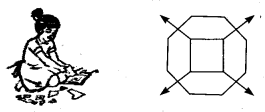
Solution:
Since, a row contains 9 dots.Therefore, number of dots in r rows = 9 r.
Number of dots in 8 rows = 9 x 8 = 72
and, number of dots in 10 rows = 9 x 10 = 90
Ex 11.1 Class 6 Maths Question 8.
Leela is Radha’s younger sister. Leela is 4 years younger than Radha. Can you write Leela’s age in terms of Radha’s age? Take Radha’s age to be x years.Solution:
Let Radha’a age be x years. Since Radha’s younger sister Leela is 4 years younger than Radha.∴ Leela’s age = (x – 4) year
Ex 11.1 Class 6 Maths Question 9.
Mother has made laddus. She gives some laddus to gilests and family members; still 5 laddus remain. If the number of laddus mother gave away is l, how many laddus did she make?Solution:
Number of laddus given to guests and family members = lNumber of laddus left over = 5
Number of laddus made by mother = 1 + 5
Ex 11.1 Class 6 Maths Question 10.
Oranges are to be transferred from larger boxes into smaller boxes. When a large box is emptied, the oranges from it fill two smaller boxes and still 10 oranges remain outside. If the number of oranges in a small box are taken to be x, what is the number of oranges in the larger box?Solution:
Number of oranges in the larger box= 2 x Number of oranges iR small box + oranges left over
= 2x +10
where x is. the number of oranges in the small box.
Ex 11.1 Class 6 Maths Question 11.
(a) Look at the following matchstick pattern of squares (see figure). The squares are not separate. Two neighbouring squares have a common matchstick. Observe the pattern and find the rule that gives the number of matchsticks in terms of the number of squares.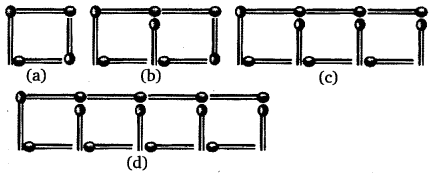
(b) Figure gives a matchstick pattern of triangles. As in Exercise 11(a) above, find the general rule that gives the number of matchsticks in terms of the number of triangles.

Solution:
(a) Clearly, from the figure:
Thus, rule is as under:
Number of matchsticks = 3x +1, where x is the number of squares,
(b) Clearly, from the figure :

Thus, rule is as under: ,
Number of matchsticks = 2x +1, where x is the number of triangles.
NCERT Solutions for Class 6 Maths Chapter 11 Algebra Exercise 11.2
Ex 11.2 Class 6 Maths Question 1.
The side of an equilateral triangle is shown by l. Express the perimeter of the equilateral triangle using l.Solution:
If P represents the perimeter of an equilateral triangle of side l, then P = l + l + l= 3 x lEx 11.2 Class 6 Maths Question 2.
The side of a regular hexagon (see figure) is denoted by l. Express the perimeter of the hexagon using l.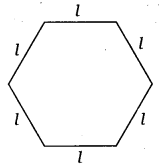
Solution:
If P represents the perimeter of a regular hexagon of side l, then P = l + l + l + l + l + l = 6 x l.Ex 11.2 Class 6 Maths Question 3.
A cube is a three-dimensional figure as shown in figure. It has six faces and all of them are identical squares. The length of an edge of the cube is given by l. Find the formula for the total length of the edges of a cube.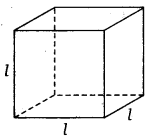
Solution:
Since all the 12 edges of a cube are of same length, l. Then, their total length = 12 x l.Ex 11.2 Class 6 Maths Question 4.
The diameter of a circle is a line, which joins two points on the circle and also passes through the centre of the circle. (In the adjoining figure AB is a diameter of the circle;C is its centre). Express the diameter of the circle (d) in terms of its radius (r).

Solution:
Diameter AB = AC + CBIf d represents the diameter of the circle and r is the radius of circle, then
d = CP + CP [∵ CP = r]
d = r + r = 2r
Ex 11.2 Class 6 Maths Question 5.
To find sum of three numbers 14, 27 and 13, we can have two ways.(a) We may first add 14 and 27 to get 41 and then add 13 to it to get the total sum 54 or
(b) We may add 27 and 13 to get 40 and then add 14 to get the sum 54.
Thus, (14 + 27) + 13 = 14 + (27 + 13).
This can be done for any three numbers. This property is known as the associativity of addition of numbers. Express this property which we have already studied in the chapter on Whole Numbers, in a general way, by using variables a, b and c.
Solution:
The given properly is stated asFor 3 variables a, b and c, we have
(a + b) + c = a + (b + c)
NCERT Solutions for Class 6 Maths Chapter 11 Algebra Exercise 11.3
Ex 11.3 Class 6 Maths Question 1.
Make up as many expressions with numbers (no variables) as you can from three numbers 5, 7 and 8. Every number should be used not more than once. Use only addition, subtraction and multiplication.Solution:
Some possible expressions using three numbers 5, 7 and 8 are(i) 5 + (8 – 7)
(ii) 5 -(8 – 7)
(iii) 5 +(8 + 7)
(iv) (5 + 8)+ 7
(v) 5 x 8 + 7
(vi) 5 x 7 + 8
(vii) 5 x 8 – 7
(viii) 5 x 7 – 8
(ix) 5 x (8 – 7)
(x) 5 x (8 + 7)
(xi) 8 x (7 – 5)
(xii) 8 x (7 + 5) etc.
Ex 11.3 Class 6 Maths Question 2.
Which out of the following are expressions with numbers only?(a) y + 3
(b) (7 x 20) – 8z
(c) 5(21 – 7) + 7 x 2
(d) 5
(e) 3x
(f) 5 – 5n
(g) (7 x 20) (5 x 10) – 45 + p
Solution:
(c) and (d) are expressions with numbers only.Ex 11.3 Class 6 Maths Question 3.
Identify the operations (addition, subtraction, division, multiplication) in forming the following expressions and tell how the expressions have been formed:(a) z +1, z – 1 y +17, y -17
(b) 17y, \(\frac { y }{ 17 } \), 5z
(c) 2y +17, 2y -17
(d) 7m, -7m + 3, -7m – 3
Solution:
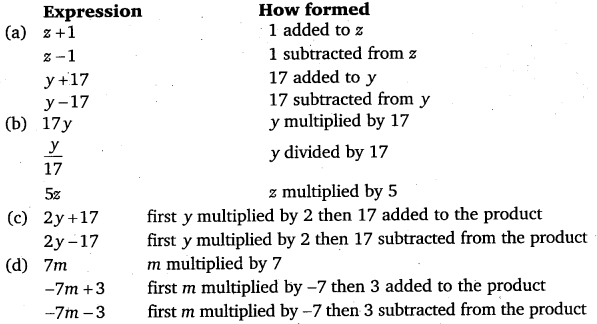
Ex 11.3 Class 6 Maths Question 4.
Give expressions for the following cases:(a) 7 added to p
(b) 7 subtracted from p
(c) p multiplied by 7
(d) p divided by 7
(e) 7 subtracted from -m
(f) -p multiplied by 5
(g) -p divided by 5
(h) p multiplied by -5
Solution:
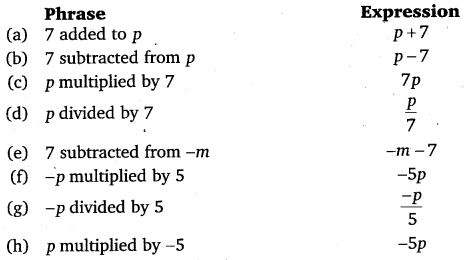
Ex 11.3 Class 6 Maths Question 5.
Give expressions in the following cases:(a) 11 added to 2m
(b) 11 subtracted from 2m
(c) 5 times y to which 3 is added
(d) 5 times y from which 3 is subtracted
(e) y is multiplied by -8
(f) y is multiplied by -8 and then 5 is added to the result
(g) y is multiplied by 5 and the result is subtracted from 16
(h) y is multiplied by -5 and the result is added to 16
Solution:
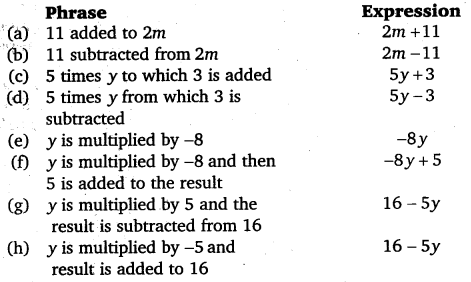
Ex 11.3 Class 6 Maths Question 6.
(a) Form expressions using t and 4. Use not more than one number operation. Every expression must have t in it.(b) Form expressions using y, 2 and 7. Every expression must have y in it. Use only two number operations. These should be different.
Solution:
(a) Possible expressions using t and 4 aret + 4, t – 4, 4t and \(\frac { t }{ 4 } \).
(b) Possible expressions using y, 2 and 7 (having only two different number operations) are
2y + 7, 2y – 7, 7y + 2, 7y – 2, \(\frac { y }{ 2 } \) + 7, \(\frac { y }{ 2 } \) – 7, \(\frac { y }{ 7 } \)+2 and \(\frac { y }{ 7 } \) – 2.
NCERT Solutions for Class 6 Maths Chapter 11 Algebra Exercise 11.4
Ex 11.4 Class 6 Maths Question 1.
Answer the following:(a) Take Sarita’s present age to be y years
- What will be her age 5 years from now?
- What was her age 3 years back?
- Sarita’s grandfather is 6 times her age. What is the age of her grandfather?
- Grandmother is 2 years younger than grandfather. What is grandmother’s age?
- Sarita’s father’s age is 5 years more than 3 times Sarita’s age. What is her father’s age?
(b) The length of a rectangular hall is 4 metres less than 3 times the breadth of the hall. What is the length, if the breadth is b metres?
(c) A rectangular box has height h cm. Its length is 5 times the height and breadth is 10 cm less than the length. Express the length and the breadth of the box in terms of the height.
(d) Meena, Beena and Leena are climbing the steps io the hill top. Meena is at step s, Beena is 8 steps ahead and Leena 7 steps behind. Where are Beena and Meena? The total number of steps to the hill top is 10 less than 4 times what Meena has reached. Express the total number of steps using s.
(e) A bus travels at v km per hour. It is going from L>aspur to Beespur. After the bus has travelled 5 hours, Beespuris still 20 km away. What is the distance from Daspur to Beespur? Express it using v.
Solution:
(a) Let Santa’s present age be y years.- Her age 5 years from now = (y + 5) years.
- Her age 3 years back = (y – 3) years.
- Since Sarita’s grandfather’s age is 6 times that of Sarita’s age.
∴ Her grandfather’s age = 6y years. - Since grandmother is 2 years younger than grandfather. Therefore,
Grandmother’s age = (6 y – 2) years. - Since Sarita’s father’s age is 5 years more than 3 times Sarita’s age.
Therefore, her father’s age = (3y + 5) years.
(b) Let the breadth of the hall be b metres
Since its length is 4 metres less than 3 times the breadth of the hall.
∴ Length of the hall = (3b – 4) metres
(c) Let the height of the rectangular box = h cm
It is given that its length is 5 times the height and breadth is 10 cm less than the length. Therefore,
Its length = 5h cm
and, breadth = (5h-10) cm
(d) Let Meena be at step s while climbing the steps to the hill top.
Since Beena is 8 steps ahead and Leena 7 steps behind Meena.
∴ Beena is at step (s + 8) and Leena is at step (s – 7)
Also, the total number of steps to the hill top is 10 less than 4 times what Meena has reached. .
∴ Total number of steps to the hill top = 4s-10
(e) Speed of the bus = v km per hour
Distance travelled by the bus in 5 hours = 5v km
According to question,
Distance from Daspur to Beespur
= Distance travelled by bus in 5 hours +20 km
= 5km +20 km = (5v +20) km.
Ex 11.4 Class 6 Maths Question 2.
Change the following statements using expressions into statements in ordinary language.(For example, Given Salim scores r runs in a cricket match, Nalin scores (r +15) runs. In ordinary language-Nalin scores 15 runs more than Salim.)
(a) A notebook costs ₹ p.A book costs ₹ 3p.
(b) Tony puts q marbles on the table. He has 8 q marbles in his box.
(c) Our class has n students. The school has 20n students.
(d) Jaggu is z years old. His uncle is 4z years old and his aunt is (4z – 3) years old.
(e) In an arrangement of dots there are r rows. Each row contains 5 dots.
Solution:
(a) A book costs 3 times the cost of a notebook.(b) Tony’s box contains 8 times the marbles on the table.
(c) Total number of students in the school is 20 times that of our class.
(d) Jaggu’s uncle is 4 times older than Jaggu and Jaggu’s aunt is 3 years younger than his uncle.
(e) The number of dots in a row is 5 times the number of rows.
Ex 11.4 Class 6 Maths Question 3.
(a) Given, Munnu’s age %p be x years, can you guess what (x – 2) may show?Can you guess what (x + 4) may show? What (3x + 7) may show?
(b) Given Sara’s age today to be y years. Think of her age in the future or in the past. What will the following expression indicate?
y + 7, y-3, y + 4\(\frac { 1 }{ 2 } \), y – 2\(\frac { 1 }{ 2 } \).
(c) Given n students in the class like football, what may 2n show? What may \(\frac { n }{ 2 } \) show?
Solution:
(a) (x – 2) may show the age of his younger sister.(x + 4) may show the age of his elder brother.
(3x + 7) may show the age of his grandfather.
(b) The expressions (y + 7), (y + 4\(\frac { 1 }{ 2 } \)) may indicate Sara’s age in future.
The expressions (y – 3), (y – 2\(\frac { 1 }{ 2 } \)) may indicate Sara’s past age.
(c) The expression 2n may show the number of students who like hockey. The expression \(\frac { n }{ 2 } \) may show the number of students who like basketball.
NCERT Solutions for Class 6 Maths Chapter 11 Algebra Exercise 11.5
Ex 11.5 Class 6 Maths Question 1.
State which of the following are equations (with a variable). Give reason for your answer. Identify the variable from the equations with a variable.(a) 17 = x + 7
(b) (t – 7) > 5
(c) \(\frac { 4 }{ 2 } \) = 2
(d) 7 x 3 – 19 = 8
(e) 5 x 4 – 8 = 2x
(f) x – 2 = 0
(g) 2m < 30
(h) 2n + 1 = 11
(i) 7 = (11 x 5) – (12 x 4)
(j) 7 = 11 x 2 + p
(k) 20 = 5y
(l) \(\frac { 3q }{ 2 } \) < 5
(m) z + 12 > 24
(n) 20 – (10 – 5) = 3 x 5
(o) 7 – x = 5
Solution:
(a) An equation, equation with variable (x).(b) Not an equation (as have no = sign).
(c) An equation, equation with numbers.
(d) An equation, equation with numbers.
(e) An equation, equation with variable (x).
(f) An equation, equation with variable (x).
(g) Not an equation (as have no = sign).
(h) An equation, equation with variable (n).
(i) An equation, equation with numbers.
(j) An equation, equation with variable (p).
(k) An equation, equation with variable (y).
(l) Not an equation (as have no = sign).
(m) Not an equation (as have no = sign),
(n) An equation, equation with numbers.
(o) An equation, equation with variable (x).
Ex 11.5 Class 6 Maths Question 2.
Complete the entries in the third column of the table.Solution:
The table duly completed is as under :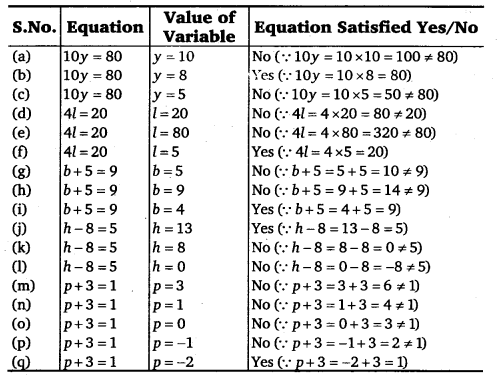
Ex 11.5 Class 6 Maths Question 3.
Pick out the solution from the values given in the bracket next to each equation. Show that the other values do not satisfy the equation.(a) 5m = 60 (10, 5, 12, 15)
(b) n + 12 = 20 (12, 8, 20, 0)
(c) p – 5 = 5 (7, 2, 10, 14)
(d) \(\frac { q }{ 2 } \) = 7 (4, -2, 8, 0)
(e) r – 4 = 0 (4, -4, 8, 0)
(f) x + 4 = 2 (-2, 0, 2, 4)
Solution:
(a) Given equation is 5m = 60.For m=10: 5m = 5 x 10 = 50 ≠ 60. So, m=10 does not satisfy the given equation.
For m = 5 5m = 5 x 5 = 25 ≠ 60. So, m = 5 does not satisfy the given equation.
For m=12: 5m = 5 x 12 = 60. So, m=12 does not satisfy the given equation.
Thus, n = 12 is its solution.
For m = 15 5m = 5 x 15 = 75 ≠ 60. So, m = 15 does not satisfy the given equation.
(b) Given equation is n +12 = 20.
For n=12: n +12 = 12 + 12 = 24 ≠ 20. So, n = 12 does not satisfy the the given equation.
For n = 8: n +12 = 8 + 12 = 20. So, n = 8 satisfies the given equation.
Thus, n = 8 is its solution.
For n = 20: n + 12 = 20 + 12 = 32 ≠ 20. So, n = 20 does not satisfy the given equation.
For n = 0: n + 12 = 0 + 12 = 12 ≠ 20. So, n = 0 does not satisfy the given equation.
(c) Given equation is p – 5 = 5.
For p = 0: p – 5 = 0 – 5 = -5 ≠ 5. So, p = 0 does not satisfy the given equation.
For p = 10: p – 5 = 10 – 5 = 5. So, p = 10 satisfies the given equation.
Thus, its solution is p = 10.
For p = 5: p – 5 = 5 – 5 = 0≠ 5. So, p = 5 does not satisfy the given equation.
For p = -5: p – 5 = -5 – 5 = -10 ≠ 5. So, p = -5 does not satisfy the given equation.
(d) Given equation is \(\frac { q }{ 2 } \) = 7.
For q = 7: \(\frac { q }{ 2 } \) = \(\frac { 7 }{ 2 } \) ≠ 7. So, q = 7 does not satisfy the given equation.
For q = 2: \(\frac { q }{ 2 } \) = \(\frac { 2 }{ 2 } \) = 1 ≠ 7. So, q = 2 does not satisfy the given equation.
For q = 10: \(\frac { q }{ 2 } \) = \(\frac { 10 }{ 2 } \) = 5 ≠ 7. So, q = 10 does not satisfy the given equation.
For q = 14: \(\frac { q }{ 2 } \) = \(\frac { 14 }{ 2 } \) = 7. So, q = 14 satisfies the given equation. Thus, q = 14 is its solution.
(e) Given equation is r – 4 = 0.
For r = 4: r – 4 = 4 – 4 = 0. So, r = 4 satisfies the given equation. Thus, r = 4 is its solution.
For r = -4: r – 4 = -4 – 4 = 8 ≠ 0. So, r = -4 does not satisfy the given equation.
For r = 8: r – 4 = 8 – 4 = 4 ≠ 0. So, r-8 does not satisfy the given equation.
For r = 0: r – 4 = 0 – 4 = -4 ≠ 0. So, r = 0 does hot satisfy thh given equation.
(f) Given equation is x + 4 = 2.
For x = -2: x + 4 = -2 + 4 = 2. So, x = -2 satisfies the given equation.
Thus, x = -2 is its solution.
For x = 0: x + 4 = 0 + 4 = 4 ≠ 2. So,- x =0 does not satisfy the given equation.
For x=2: x + 4= 2 + 4= 6 ≠ 2. So, x = 2 does not satisfy the given equation.
For x = 4: x + 4 = 4 + 4= 8 ≠ 2. So, x = 4 does not satisfy the given equation.
Ex 11.5 Class 6 Maths Question 4.
Question (a)Complete the table and by inspection of the table find the solution to the equation m +10 = 16.

Solution:
Completing the table, we have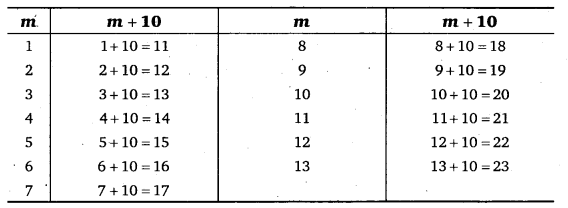
By inspection of the above table, we find that m = 6 satisfies the equation m+10 = 16. So, m = 6 is its solution.
NCERT Solutions for Class 6 Chapter 11 Question (b)
Complete the table and by inspection of the table find the solution to the equation 51 = 35.
Solution:
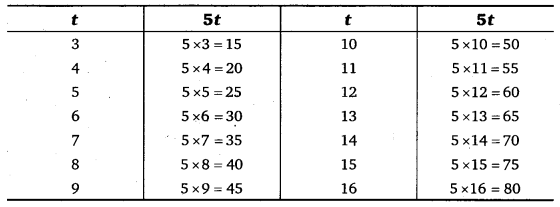
By inspection of the above table, we find that t = 7 satisfies the equation 5t = 35. So, t = 7 is its solution.
NCERT Solutions for Class 6 Chapter 11 Question (c)
Complete the table and find the solution of the equation \(\frac { z }{ 3 } \) = 4 using the table.
Solution:
Completing the table, we have

By inspection of the above table, we find that t=12 satisfies the equation \(\frac { z }{ 3 } \) = 4. So, t = 12 is its solution.
NCERT Solutions for Class 6 Chapter 11 Question (d)
Complete the table and find the solution to .the equation m – 7 = 3.
Solution:
Completing the table, we have
By inspection of the above table, we find that m = 10 satisfies the equation m – 7 = 3. So, m = 10 is its solution.
Ex 11.5 Class 6 Maths Question 5.
Solve the following riddles, you may yourself construct such riddles.Who am I?
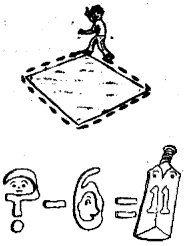
(i) Go round a square
Counting every comer Thrice and no more!
Add the count to me
To get exactly thirty four!
(ii) For each day of the week
Make an upcount from me
If you make no mistake
You will get twenty three!
(iii) I am a special number
Take away from me a six!
A whole cricket team
You will still be able to fix!
(iv) Tell me who I am
I shall give a pretty clue!
You will get me hack
If you take me out of twenty two!
Solution:
(i) Let I be denoted by x. There are 4 comers of a square.On counting each comer thrice, we get 3 x 4 = 12
As per problem:
x + 12 = 34 ⇒ x +12 – 12 = 34 – 12
⇒ x + 0 = 22 ⇒ x = 22
Thus, I am 22.
(ii) According to the question:
x + 7 =23
x + 7 – 7 = 23 – 7
⇒ x + 0 =16 ⇒ x =16
(iii) Let the special number be x. Then, according to the problem, we have
x – 6 = 11 [ In a cricket team, no. of players =11]
⇒ x – 6 + 6 = 11 + 6
⇒ x + 0 = 17 ⇒ x = 17
Thus, the special number is 17.
(iv) Let I be denoted by x.
According to the question:
22 – x = x
⇒ 22 – x + x = x + x
⇒ 22 + 0 =2x
⇒ 2x = 22 ⇒ \(\frac { 2x }{ 2 } =\frac { 22 }{ 2 } \)
⇒ x =11
Thus, I am 11.
NCERT Class 6 Maths
Class 6 Maths Chapters | Maths Class 6 Chapter 11
NCERT Solutions for Class 6 Maths
NCERT Solutions of Maths Class 6 Chapter-wise
Chapter-wise NCERT Solutions for Class 6 Maths
-
NCERT Solutions For Class 6 Maths Chapter 1 Knowing Our Numbers
NCERT Solutions For Class 6 Maths Chapter 2 Whole Numbers
NCERT Solutions For Class 6 Maths Chapter 3 Playing With Numbers
NCERT Solutions For Class 6 Maths Chapter 4 Basic Geometrical Ideas
NCERT Solutions For Class 6 Maths Chapter 5 Understanding Elementary Shape
NCERT Solutions For Class 6 Maths Chapter 6 Integers
NCERT Solutions For Class 6 Maths Chapter 7 Fractions
NCERT Solutions For Class 6 Maths Chapter 8 Decimals
NCERT Solutions For Class 6 Maths Chapter 9 Data Handling
NCERT Solutions For Class 6 Maths Chapter 10 Mensuration
NCERT Solutions For Class 6 Maths Chapter 11 Algebra
NCERT Solutions For Class 6 Maths Chapter 12 Ratio and Proportion
NCERT Solutions For Class 6 Maths Chapter 13 Symmetry
NCERT Solutions For Class 6 Maths Chapter 14 Practical Geometry
NCERT Solutions for Class 6 to 12
-
NCERT Solutions for Class 6 All Subjects
NCERT Solutions for Class 7 All Subjects
NCERT Solutions for Class 8 All Subjects
NCERT Solutions for Class 9 All Subjects
NCERT Solutions for Class 10 All Subjects
NCERT Solutions for Class 11 All Subjects
NCERT Solutions for Class 12 All Subjects

Post a Comment
इस पेज / वेबसाइट की त्रुटियों / गलतियों को यहाँ दर्ज कीजिये
(Errors/mistakes on this page/website enter here)